
In our last blog we looked at 12 essential items that you should have with you when venturing outdoors, the first five being the most important as they are the most difficult and time consuming to re-produce in nature. These were a cutting tool, combustion device, covering/shelter, metal container and cordage.
In this blog we will be focussing on the first of those items which is a cutting tool (knife) and why it is the most important tool of all to have with you.
Why is a cutting tool so important?
Everything that we own, travel in, live in or use in our daily lives is made using some kind of cutting tool. From the clothes we wear to the houses we live in, a cutting tool of some description is used in their manufacture. In its simplest form, when out in the bush and away from man made habitation this comes down to a simple knife, saw or axe. In the bush, with just a knife, everything else you need can be constructed using knowledge and skill.
The origins of knife crafting
For 80% of mans existence, cutting tools were crafted using flint and stone technology. Early man and traditional cultures across the world have made cutting tools, scrapers, saws, arrow heads and tools to hunt with or make or shape the things that they needed for their daily lives.
The practise of flint knapping as it is known today, is the shaping of flint, chert, obsidian, quartz or other conchoidal fracturing stone through the process of lithic reduction to manufacture stone tools, knives, arrow heads or strikers for flintlock firearms.
Knapping was a very important and precise skill set needed to make these tools, gleaned from thousands of years of trial and error. Without the resources or the knowledge of how to make cutting tools, life would have been very difficult if not impossible in some places.
From the Bronze Age to the Iron Age and right up to to the manufacture of steel, the art of cutting tool creation has been refined to create superior, sharper and more durable cutting tools than their early flint counterparts. So unless you have a knowledge of flint knapping and can access flint or chert deposits, which are quite scarce, then you had better make sure you have a good knife.
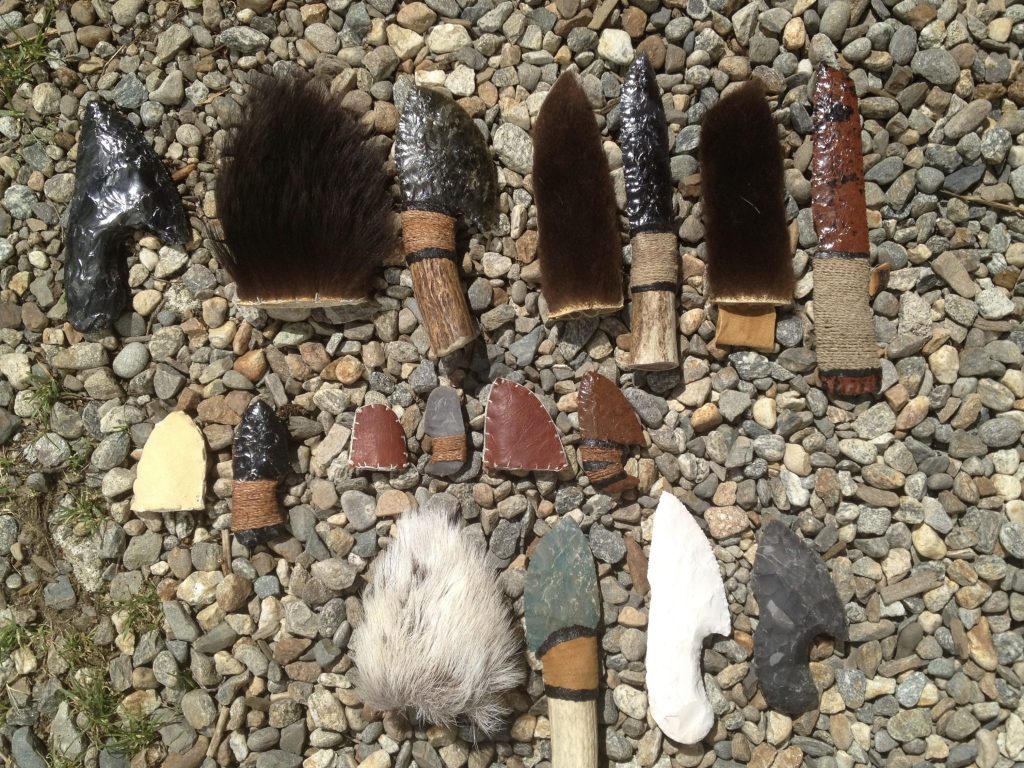
Choosing a knife
There are literally thousands of knives in the marketplace to choose from so how do you know which one to pick? Probably the most important thing you need to ask yourself is what do you need the knife for! Some knives are specially designed for wood carving, some for cutting rope, some for skinning, some for chopping, while others are used in surgery or in the kitchen and some are just general purpose knives.
Knife Grinds & Bevels
There are 4-5 primary knife grinds, each consisting of either a primary or secondary bevel, or both; conventional grind, flat grind, hollow grind (concave), convex grind and Scandi grind (tapered).
Conventional grind knives account for probably 50% of most factory made knives, multi tools and pocket knives. They are a compromise between blade strength and sharpness. Due to the very narrow secondary bevel on these knives it makes it hard to maintain a consistent angle when sharpening unless using an angled sharpening tool.
Hollow grind (concave) knives are very sharp as they have a thinner blade profile so they are great for skinning and are the profile used for surgical knives. This thinner profile however makes the blade weaker and prone to snap when used for general cutting or battoning.
Convex grind profiles are used for robust tools that are designed to chop and split wood such as axes and some machetes.
Scandi grind (tapered) knives are used in bushcraft, woodcraft and wilderness activities as they are a good compromise of strength, sharpness and edge retention. They have a good all round design that can be used for general cutting, skinning, carving and battoning. They also have a large flat primary bevel with no secondary bevel which makes them easy to re-sharpen and maintain a consistent blade angle.

Carbon vs Stainless steel
Stainless steel is not prone to rust and retains its edge for longer yet is harder to re-sharpen (great for marine and wet environments).
Carbon steel is easier to re-sharpen in the field yet looses its edge faster and is prone to rust if not looked after properly. It can also be used to create sparks when struck with flint or chert for flint and steel fire making.
Serrations and saws on knives
Serrated blades are primarily for cutting rope and strapping but are not much good for anything else, they are also very difficult to re-sharpen in a field environment, so unless you plan on doing a lot of rope cutting, steer away from a knife that has serrations anywhere on the knife as this prevents the knife being used for other more useful tasks. You are better to carry a separate multi tool such as a Leatherman that has a purpose built serrated blade.
The same holds true for saws on the back of fixed blade knives, as these generally only ever cut down to the depth of the teeth then get stuck because the sides of the knife are the same width as the teeth, rather than the teeth being splayed wider than the width of the knife, creating a gap and thereby reducing friction and allowing the saw to cut without getting stuck.
Saws on the back of fixed blade knives also inhibit the back of the knife being able to be utilised for other tasks such as stripping bark or used in conjunction with a Ferrocerium rod/Fire steel for fire lighting (a 90 degree edge on the back of the knife is needed for this).
It is far better to carry a separate purpose built pocket folding saw such as a Bacho Laplander folding saw. Victorinox pocket knives and Leatherman multitools also have saws in them that cut well and are great for small notching tasks.
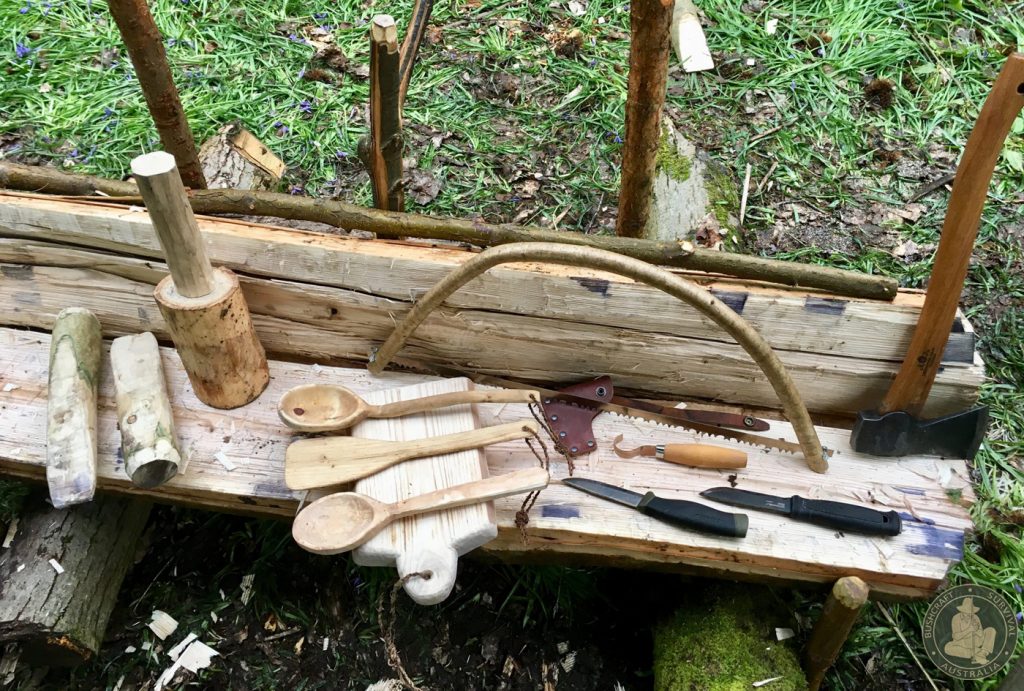
What NOT to choose
Probably the best example of what you “don’t” want in an outdoor knife are the classic “Rambo” type knives with survival kits and a compass in the handle, saws and serrations on the blade or the spine. These knives are gimmicks and designed to “look good” rather than have any real functional use. A knife with a survival kit in the handle won’t even be half tang so is prone to breakage, also if you loose your knife then you have lost your survival kit as well, not that you could fit anything of real use in something so small in the first place! Serrations and saws as mentioned above will inhibit using the knife for other more vital tasks. Double edged knives are designed as fighting knives and have no use as a general outdoor bush knife. So unless you are in a military unit that does a lot of close quarter fighting and you can’t use your primary weapon, then stay clear of these types of knives. They are also illegal in Australia.

The ideal cutting tool
As stated earlier, your choice of cutting tool is primarily determined by where you are and what you need it for. In the Boreal forests of the northern hemisphere this might be a forest axe, capable of felling trees, splitting and chopping wood to build shelters or process fire wood to keep a long log fire going to keep you warm. In a tropical environment this could be a machete or a parang, capable of slashing vines and undergrowth, splitting bamboo or processing coconuts.
For bushcraft and general outdoor use in a temperate environment, a folding saw and a full tang belt knife with a 5 to 5.5 inch, 3.2 mm thick, Scandi grind, carbon steel blade with a sharp 90 degree spine is ideal. This would afford you with a strong robust knife capable of a variety of tasks such as cutting, carving, skinning, stripping and battoning.
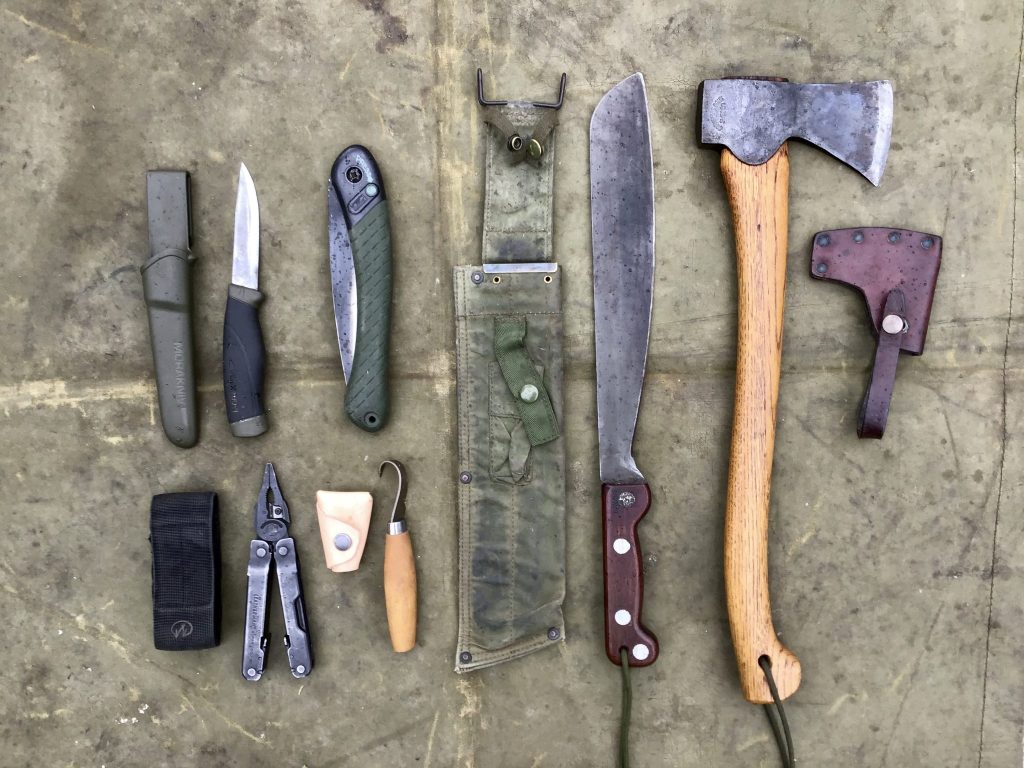
The Swedish knife company Morakniv make a good selection of very affordable high quality Scandi grind knives perfectly suited for bushcraft and other outdoor activities. Many of the leading bushcraft and survival schools around the world as well as many military units use Morakniv knives.
Some of the commonly used models for bushcraft, survival and outdoor use are as follows:
Companion Heavy Duty MG: This is the general entry knife used and issued at many bushcraft and survival schools around the world. It is strong and robust and capable of performing a variety of outdoor tasks. It has a ¾ tab tang Scandi grind blade but does not have a 90 degree spine for fire steel use, this can be easily done with a file though. The new Companion Spark (slightly thinner blade) however comes with a 90 degree spine and small Ferro Rod. The Companion HD MG retails for about $40 AUD making it one of the most affordable and good quality knives anywhere.
Bushcraft Black (tactical MOLLE sheath): Specifically made for bushcraft and field use, the ¾ tab tang high carbon steel blade has an anti corrosive black coating and the spine is ground especially for use with a fire steel. The MOLLE compatible sheath makes it great for military use. It retails for about $90 AUD with standard polymer sheath or $135 AUD with tactical MOLLE sheath.
Kansbol: This forest knife has a ¾ tab tang hybrid blade profile of both Scandi and hollow grind, making it great for hunting and skinning tasks as well as general wood cutting and carving. It retails for about $80 AUD.
Garberg: This is Morakniv’s only full tang blade and their strongest and most robust knife, allowing it to be used for a variety of tough tasks such as heavy battoning and survival use. It has a 3.2mm Scandi grind blade with 90 degree spine and comes in stainless or high carbon steel. It comes with a sturdy leather sheath or a Multi-mount system. It retails for about $250 AUD.
Morakniv also make a range of specialist woodcarving and hook knives.
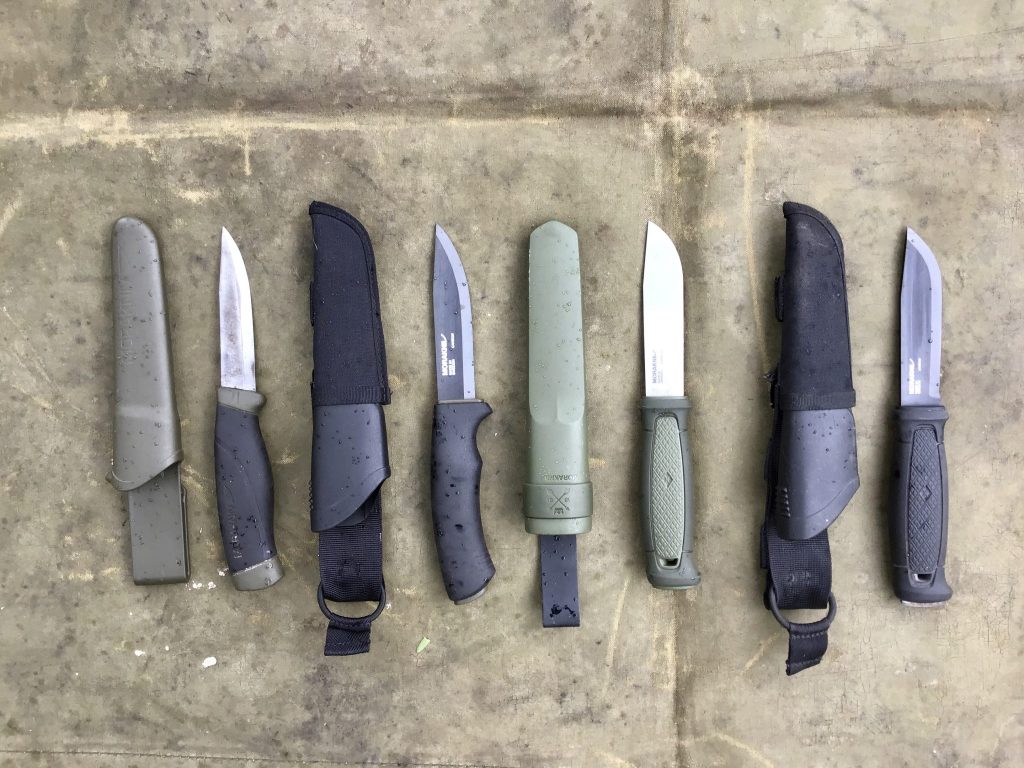
An important reminder
Traditional hunter/gatherers around the world still use knives for their daily living that modern bushcrafters and outdoor enthusiasts would consider inferior, yet they are able to survive and even thrive out in the wilderness. Remember – it doesn’t matter what knife you own, it’s the knowledge of “how” to use it that is more important!
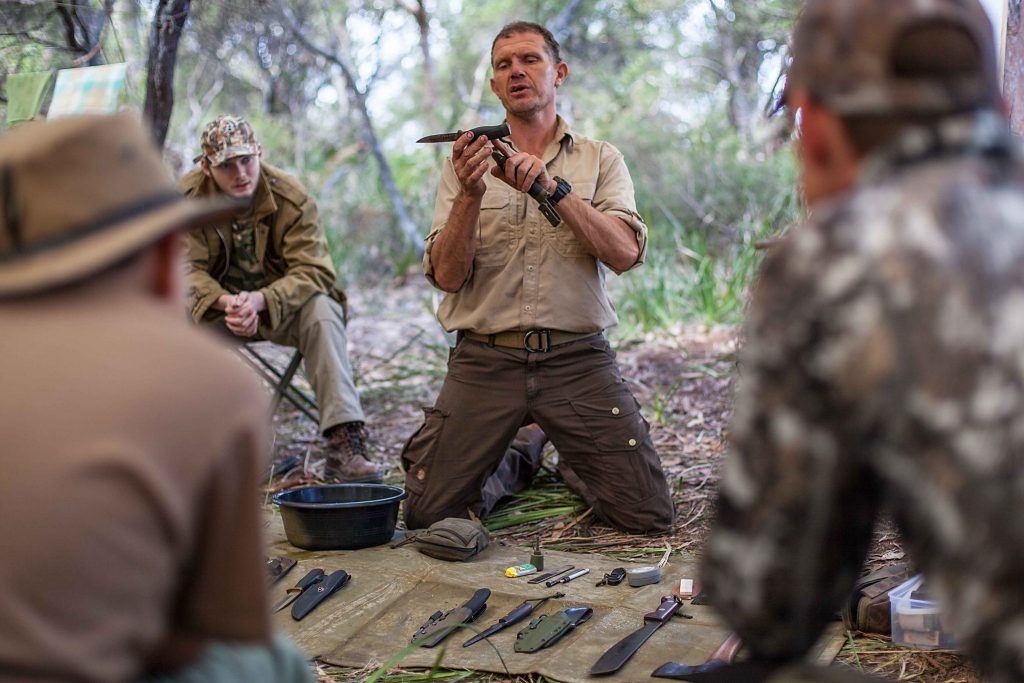

I never really appreciated knives until I did my first Bushcraft Survival course. It opened my eyes up to how useful a tool a good knife is, and the difference between a good knife and one that is just made to ‘look cool’, but that wouldn’t actually be much help in a survival situation.
Thanks Nat, not many of those “cool” knives are good in any situation. However the best knife is the one you have with you at the time.
Hello. Looking for reliable outdoor knife within the adequate price. My budget is 100$. Please advise.
Great article Gordo. Very comprehensive. Having a quality knife really does make a world of difference.
As does proper care, maintenance and sharpening technique.
Be great if you could do an article on proper care and maintenance as a follow on to this one.
Thanks Garry, noted. A follow on is in the pipeline after the next few topics. I appreciate your input.
Another great Blog Gordon.
So many people are scared of knives and even more are scared to let there kids learn how to use a knife, yet it is a skill we use everyday especially once we enter adulthood. I think it is important to teach kids when they are young how to use a knife safely. So far all the kids I have taught have become more respectful of the knife once given the opportunity to learn and use a knife.
Keep up the good work Gordon and stay safe.
Thanks for your comments Justin. Choosing and using a knife correctly and safely is something that is very undervalued today. The best knife to have is whatever knife you have with you at the time. Thanks Justin
Was watching some of your earlier videos and was wondering what knife you were using before you switched to mora knives thanks
I didn’t actually switch to Mora, I use many different knives all the time. The knife I often use and the one you are referring to is a Ray Mears Bushcraft Knife made by Allan Wood in the UK. A very good knife, although very expensive.
Thanks for reading.
Best explanation of grind types I have seen. The diagram says more than most of the youtube videos on knife types.
Thanks Gordon.
I’m glad you enjoyed the article Paul. It was a mix of various combinations of texts, courses both civilian and military as well as personal experience that went into that as I also found it frustrating that many things were not clearly explained.
Thanks for taking the time to read it.
Gordon
The most suitable bushcraft knife is a necessary tool for the bushcrafter. There’s probably no bushcraft knife as easy and memorable. In the majority of cases, you will employ your bushcraft knife along with different knives and tools.
Excellent read and so on point with the info, more people should read this before pulling the pin on a new bush blade.
I must ask though, how do you find the Garberg riding in the bushcraft black sheath?
I’m really interested in that set up.
All the best
This is the greatest post. I want to recommend this valuable information what is really helpful for the all knife user.
I’m very glad you found it helpful Sophia. Please feel free to share it to help others who you think it may be of use to. Thanks for reading and your support.
Thanks for another great blog, the explanation on “Knife grinds and bevels” as well as “Carbon vs Stainless steel” are clear and concise. I also apreciate that you recommend affordable knives, I have a Morakniv Companion and I do like it. The Scandi grind is easy to keep sharp that increases my confidence in using the knife long term.
Thanks for the useful information Gordon. These articles are really informative and I’m looking forward to taking your bushcraft course in person soon!
This is very informative. Each knife has its own purpose and it’s definitely very important to choose the right one depending on your needs. Just a quick question, what are your thoughts on Benchmade knives?
The most suitable bushcraft knife is a necessary tool for the bushcraft. There’s probably no bushcraft knife as easy and memorable. In the majority of cases, you will employ your bushcraft knife along with different knives and tools. I recommend it to buy today from Almazan knives. Shop: https://bit.ly/3VKHtc4
What an informative article! I appreciate the deep dive into the world of knives, particularly their historical development and the importance of choosing the right knife for the right situation. I’d like to mention a point on kitchen knives, as they seem to be a relative of these outdoor knives in many ways. A sharp kitchen knife is actually a crucial tool in everyday life. Just as a well-made outdoor knife can make survival and bushcraft easier and more efficient, a sharp kitchen knife can elevate your cooking experience. When you use a sharp kitchen knife, you can ensure cleaner and more precise cuts, which not only makes your food look more aesthetically pleasing, but also impacts the way it cooks. Uniform pieces of food cook evenly, ensuring every bite is as good as the last. Additionally, the ease with which a sharp knife goes through the food actually makes the cooking process safer, reducing the risks of slips or mishaps. Much like how the right outdoor knife is determined by its environment and purpose—as the article adeptly describes—kitchen knives are also defined by their application, whether that’s deboning a chicken or finely dicing vegetables. Overall, both outdoor and kitchen knives underscore the importance of using the right tools for the task at hand. And always remember, a sharp knife is a safe knife, whether in the wilderness or in the kitchen.
https://www.justknives.com.au/